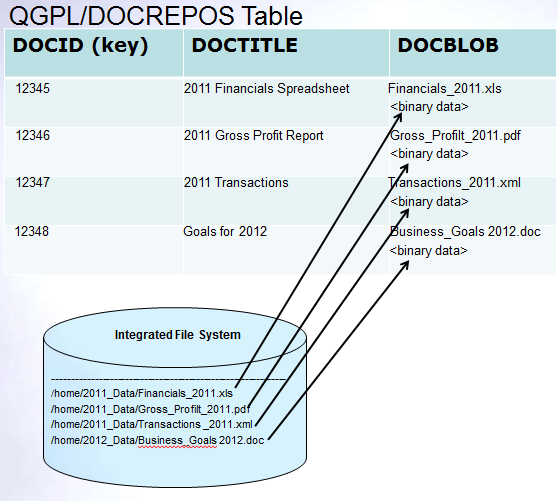There's no need to be afraid. Learn how to use RPG to load and extract binary data to and from DB2 BLOB columns.
Written by Gene Cobb
While vampires and zombies are all the rage these days, menacing invaders from outer space used to be the fright night monster du jour. Remember The Blob starring Steve McQueen? While this terrifying, bubbly alien may conjure up images of panic-stricken people running frantically through the streets, the database BLOB is actually something that should be…well…embraced!
Don't worry. The database BLOB bears little resemblance to the giant glob of goo that terrorized a rural Pennsylvania town and devoured its victims. The database version is a built-in DB2 data type that allows you to store vast amounts of unstructured data as a single entity in a column. In fact, the LOB portion of the name stands for Large Object. There are actually three different types of LOB data types in DB2:
- CLOB (Character Large Object)—Large character string data type that is compatible with CHAR and VARCHAR types
- DBCLOB (Double-Byte Character Large Object) —Large double-byte character string data type that is compatible with GRAPHIC and VARGRAPHIC types
- BLOB (Binary Large Object)—Binary data type. Ideal for storing scanned documents, digital images, PDF documents, Word documents, XLS spreadsheets, etc.
In this TechTip, we focus on the BLOB, a data type that gives you a centralized, secure place to store your PDF files, your presentations, even your important spreadsheets and documents!
Think about that for a moment. Instead of storing these types of binary files on multiple PCs throughout your network, a shared PC/file server, or even the Integrated File System (IFS) of the IBM i, you can tuck them neatly away in your DB2 for i tables! Want to tidy things up and get organized? Store the sales invoice image in the same row as the sales transaction! Have a bunch of employee resumes in PDF format? Keep them in the Human Resources table along with all their other employee personnel information. Still not convinced? Then consider these additional advantages:
- Ease of access—Use SQL selection (WHERE clause) to easily locate and retrieve a particular image or document based on other columns in the table, such as customer name or order date.
- Security—In addition to IBM i object-level security, leverage the power of SQL to implement row-level security using SQL views to restrict row access to certain users. In addition, by using a combination of views and user-defined functions (UDFs), you can even restrict user access to specific columns. For more information on these techniques, see the article titled "Using SQL Views and Stored Procedures to control Security with DB2 Web Query" at this URL.
- Text searching—Use the IBM i OmniFind product to perform searching of text within the documents stored in the BLOB. More information can be found here.
- Simplified backup and recovery—Saving the table means you save both the data and the stored documents! Ditto on the restore!
- One version of the truth—A BLOB provides a centralized, secure location to store the master copies of documents. Eliminate the common problem of multiple versions of the truth floating around within your organization.
Creating a Table with a BLOB Column
Now that you're a BLOB believer, the first step is to create a table with a BLOB column. Because there is no DDS support for LOB data types, this can be done only by using SQL Data Definition Language (DDL). In the following example, you create a three-column table to hold the document identifier (DOCID, which can be used as a unique or primary key), the document title (DOCTITLE), and the binary document itself (DOCBLOB, the BLOB column):
CREATE TABLE QGPL/DOCREPOS (
DOCID ROWID GENERATED ALWAYS,
DOCTITLE CHAR(200) DEFAULT NULL ,
DOCBLOB BLOB(524288000) DEFAULT NULL)
Using RPG to Load Binary Files into BLOB Columns
Now that the table has been created, you're ready to insert rows and load your documents into the BLOB. An easy way to set the stage for this is to first move your documents to a holding directory on the IFS. From there, they can be loaded directly into the table. This process is illustrated in Figure 1 below, where the files are first copied to the IFS directory /home/2011_Data/ and then loaded into the table.

Figure 1: Load documents from IFS into the BLOB.
So how do you do this? Does moving data into LOB columns mean you have to write utility routines, code to complex APIs, and create a bunch of host variables? Nope! A simple RPG program will do the trick! The following SQLRGPLE example reveals just how easy it is.
|
D MYFILE S SQLTYPE(BLOB_FILE) D SQL_FILE_READ... D c const(2) D c const(16) d newDocID s 9B 0 d newDocTitle s 200a /free newDocTitle = '2011 Financials Spreadsheet'; myfile_fo = SQL_FILE_READ; myfile_name = '/home/2011_Data/Financials_2011.xls'; myfile_nl = %len(%trimr(myfile_name)); exec SQL insert into QGPL/DOCREPOS (docTitle, docBLOB) values(:newDocTitle, :myfile); return; /end-free |
In this program, you assign the document title, open/read the file located on the IFS, provide the name and length of the location of that file, and finally issue the SQL insert statement to add the row to the table.
To understand this better, let's examine what happens during the SQL precompiler process. Notice the first line in the example program above (the BLOB_FILE data type definition for the variable MYFILE). This variable is translated by the SQL precompiler into the following data structure:
D MYFILE DS
D MYFILE_NL 10U 0
D MYFILE_DL 10U 0
D MYFILE_FO 10U 0
D MYFILE_NAME 255A
Four special suffixes are appended by the precompiler to the variable name to form four additional fields. These are referred to as LOB file reference variables, and they can be used in your programs to facilitate the movement of LOB values to and from the table:
_NL—Length of the file name
_DL—Length of the data
_FO—File option. Valid values are:
- 2 (SQL_FILE_READ) – Indicates that is a regular file that can be opened, read, and closed.
- 8 (SQL_FILE_CREATE) - Creates a new file. If the file already exists, an error message is returned.
- 16 (SQL_FILE_OVERWRITE) – Creates a new file. If the file already exists, it is overwritten with the new data
- 32 (SQL_FILE_APPEND)
_NAME—The name of the file (the actual full path or location on the IFS)
To instruct the program to open and read a file on the IFS, you simply set the file option variable to a value of 2 (for SQL_FILE_READ). Next, supply the name of the file's location on IFS, as well as the length of this name. Finally, issue the INSERT statement to add a new row to the table. During the insert process, the referenced file in the IFS will be copied into the BLOB column. So easy!
Using RPG to Extract Binary Files from BLOB Columns
So now the binary data is safely tucked away in the BLOB. What happens in the future when you need to access the data in the BLOB? You simply write the file back out of the IFS. Just use the appropriate file options to instruct the program to go the other direction. The following RPG example does just that.
|
D MYFILE S SQLTYPE(BLOB_FILE) D SQL_FILE_OVERWRITE... D c const(16) /free myfile_fo = SQL_FILE_OVERWRITE; myfile_name = '/home/2011_Data/Financials_2011.xls'; myfile_nl = %len(%trimr(myfile_name)); exec SQL SELECT docblob INTO :myfile FROM QGPL/DOCREPOS WHERE DocTitle = '2011 Financials Spreadsheet'; return; /end-free |
In this example, you set the file option variable to SQL_FILE_OVERWRITE, assign the value and length of the name of the target file, and finally specify an SQL SELECT to find the row with the binary data you're looking for. When the SQL statement is executed, it creates a new file on the IFS named /home/2011_Data/Financials_2011.xls. If that file happens to already exist in that directory, it's overwritten with the data from the BLOB column. Hmmm…so in effect the database BLOB will devour the existing spreadsheet. On second thought, maybe it does have some of the same characteristics as "The Blob"! Run for your lives!!
Summary
LOB columns are a great way to store large amounts of unstructured data, whether they're in textual or binary format. They provide a mechanism for storing these types of data sources in an organized and secure manner; and by using the file reference variables available in the SQL precompiler, it's extremely easy to load and extract this data to and from LOB columns. I strongly encourage you to give BLOBs a try in your shop. However, if custodians start mysteriously disappearing…












 Business users want new applications now. Market and regulatory pressures require faster application updates and delivery into production. Your IBM i developers may be approaching retirement, and you see no sure way to fill their positions with experienced developers. In addition, you may be caught between maintaining your existing applications and the uncertainty of moving to something new.
Business users want new applications now. Market and regulatory pressures require faster application updates and delivery into production. Your IBM i developers may be approaching retirement, and you see no sure way to fill their positions with experienced developers. In addition, you may be caught between maintaining your existing applications and the uncertainty of moving to something new. IT managers hoping to find new IBM i talent are discovering that the pool of experienced RPG programmers and operators or administrators with intimate knowledge of the operating system and the applications that run on it is small. This begs the question: How will you manage the platform that supports such a big part of your business? This guide offers strategies and software suggestions to help you plan IT staffing and resources and smooth the transition after your AS/400 talent retires. Read on to learn:
IT managers hoping to find new IBM i talent are discovering that the pool of experienced RPG programmers and operators or administrators with intimate knowledge of the operating system and the applications that run on it is small. This begs the question: How will you manage the platform that supports such a big part of your business? This guide offers strategies and software suggestions to help you plan IT staffing and resources and smooth the transition after your AS/400 talent retires. Read on to learn:
LATEST COMMENTS
MC Press Online